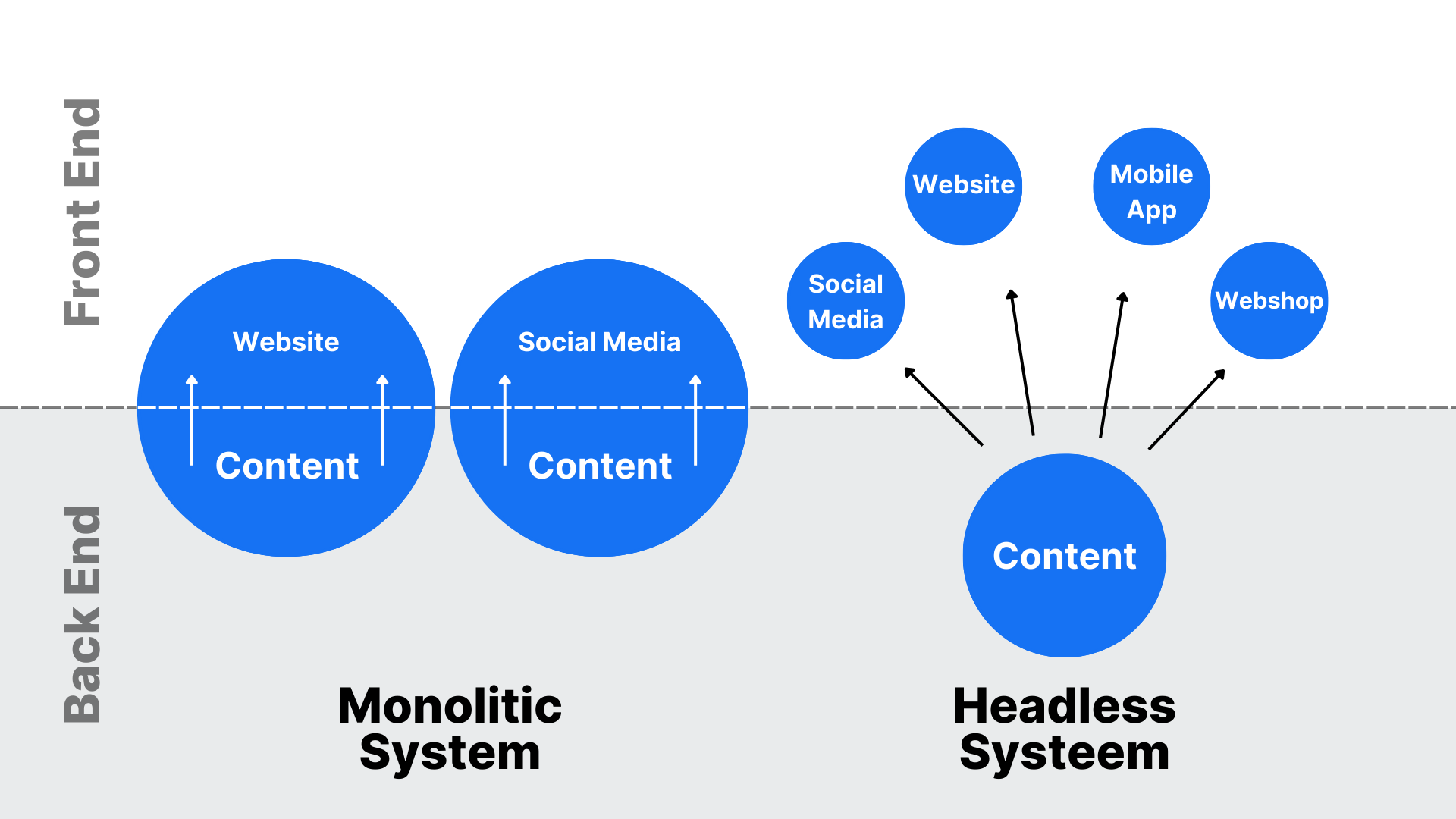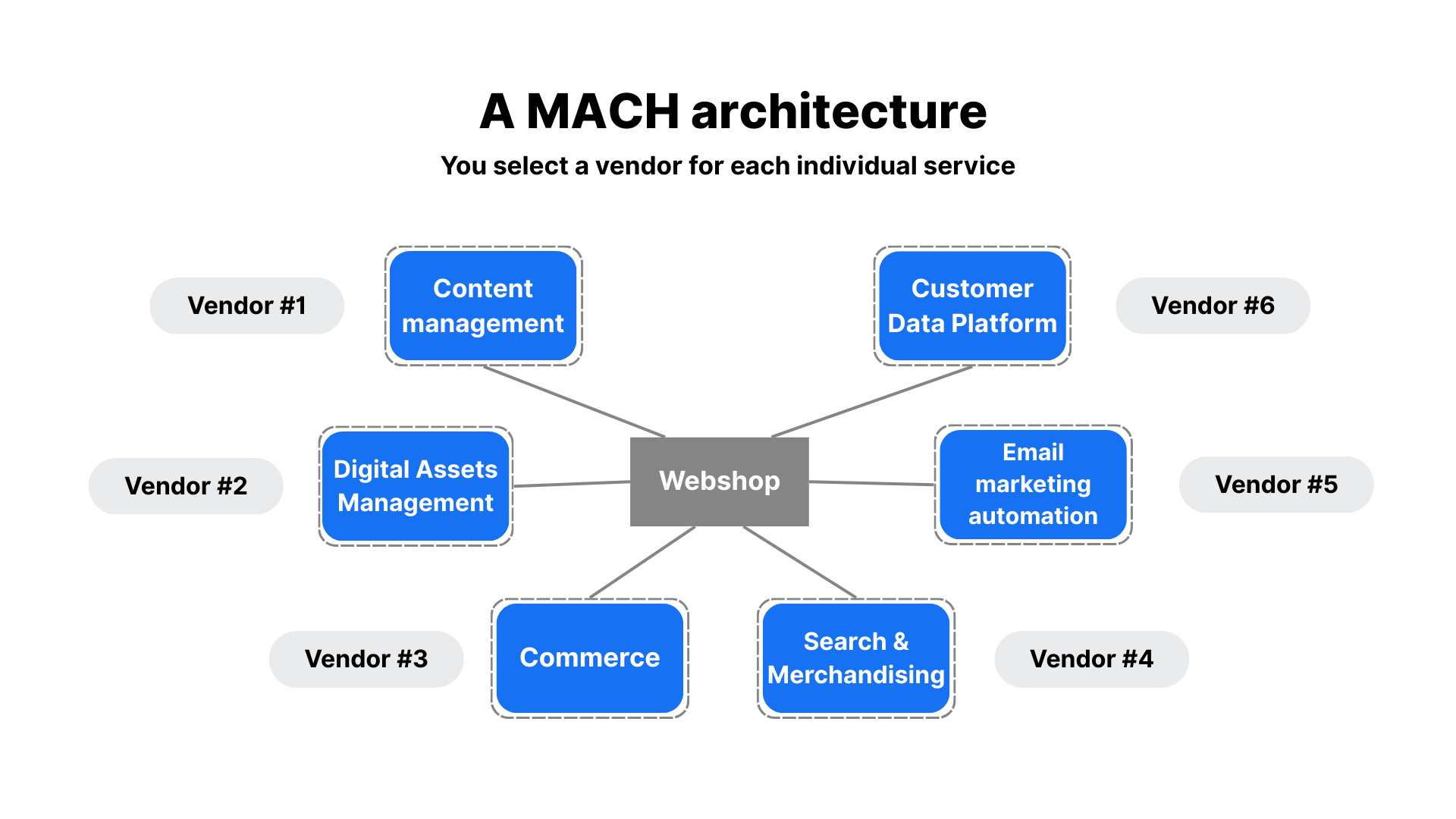Today's customers expect seamless, personalized experiences across a variety of channels: websites, mobile apps, smart devices, and even AI assistance. For businesses, this means that traditional, All-In-One software solutions are increasingly falling short. They're not flexible enough and make it difficult to respond quickly to these changes.
The solution? A MACH architecture: a modern, modular approach that prioritizes flexibility, scalability, and agility. But what exactly is a MACH architecture, and how does it work?
The term MACH stands for Microservices, API-first, Cloud-native SaaS, and Headless. This is an IT architecture designed to enable companies to modernize their digital solutions and optimally adapt them to their unique needs.
Microservices: All functions are split into small, independent services that can be developed and managed independently. Think of services for customer management, payments, or product recommendations.
API-first: The various components of a system communicate via well-documented API's. This ensures that all components work together flexibly.
Cloud-native SaaS: All applications run in the Cloud, so they automatically benefit from scalability, high availability and the latest updates.
Headless: The front-end (such as a website or app) is separate from the back-end, allowing you to serve multiple channels without limitations on design or functionality.

The structure of a Headless System.
Instead of using an All-In-One platform, a MACH architecture allows you to assemble your IT landscape from various best-of-breed services. This means you choose the most suitable provider for each service, ensuring your entire platform fully aligns with your unique needs. All these services work seamlessly together thanks to Application Programming Interfaces (APIs): a piece of programming that ensures all services exchange information and function as a whole. This allows you to create a fully customized system that perfectly matches the needs of your organization.
If your requirements change or a specific service no longer meets your needs, you can replace it without modifying the rest of your system. This makes MACH not only future-proof but also extremely flexible.

With a MACH architecture, you choose the best tools and services for your organization. Consider, for example:
Commerce: Features such as a shopping cart, payments and order management.
Contentmanagement: For managing and publishing content across multiple channels.
Search and personalization: TTools that deliver relevant search results and customer-focused recommendations.
Analytics: Services that give you insight into the behavior and preferences of your customers.
Developing a MACH architecture requires a strategic approach and knowledge of the various available services. Therefore, it's important to collaborate with an experienced partner who can advise you on the best solutions for your situation.
The transition to a MACH architecture (Microservices, API-first, Cloud-native, and Headless) offers companies the opportunity to elevate their digital strategies. Besides the practical benefits, this approach offers a broader vision for innovation and agility.
Flexibility
When customers develop new expectations or your organization grows, you can quickly respond to these changes by adapting or updating specific components. Add new services, replace outdated components, and quickly adapt to new requirements.
Scalability
Cloud-native solutions scale with your organization. Whether you're expecting a peak during a marketing campaign or planning international expansion, your platform can handle it.
No vendor lock-in
Instead of being dependent on a single vendor —also known as vendor lock-in— MACH allows you to choose the best tools and partners yourself. This prevents you from being stuck with limited solutions or high costs.
Innovation
The modular approach, allowing you to add and remove services whenever you want, allows you to experiment with new technologies and quickly respond to market trends.
Always the best tools
With MACH, you have complete control over your own technology. You choose the tools that truly suit your organization, for optimal results.
MACH goes beyond just technology; it's a certified approach. The non-profit organization, the MACH Alliance, assesses and certifies companies that create transformative, open, and best-of-breed solutions. The affiliated services and platforms within the MACH Alliance are rigorously monitored and must meet clear requirements. This guarantees quality, compatibility, and a future-oriented approach.
At Aviva Solutions, we utilize solutions from MACH Alliance partners to provide our customers with the most innovative and future-proof technologies. These partners have been rigorously assessed and meet the MACH Alliance's high standards, ensuring we can offer our customers the best tools and technologies.
Want to learn more about MACH architecture and what it can do for your organization? Contact us.
A MACH architecture offers organizations the flexibility they need to respond to today's rapidly changing digital demands. By combining best-of-breed services and avoiding vendor lock-in, you create a platform that not only meets your current needs but can also easily grow with your organization. Whether it's personalized customer experiences, scalable cloud solutions, or innovative technologies: with a MACH architecture, you always stay one step ahead.
Get advice from our experts and discover how your organization can benefit from the advantages of a MACH architecture!
We'll teach you everything you need to know about this powerful way of building ecommerce platforms.
Continue readingThe smallest changes have massive impact.
Continue readingWant to stay informed about everything happening with Composable Commerce? Sign up for our updates here!
We've built converting e-commerce platforms for our customers for more than 15 years.
You don't just pick a new e-commerce platform. Especially with the sheer volume of available vendors and services. What's the best course of action? Together we will determinate the technical solution that best fits your business goals. Do you want to know how we approach e-commerce projects? We'd love to start a conversation!
Get the right insights!E-Commerce Solutions Specialist
Digital Experience Expert